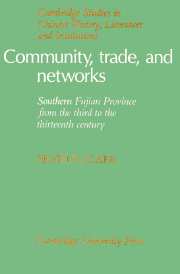Book contents
- Frontmatter
- Contents
- List of maps and tables
- Acknowledgments
- 1 Problems and approaches
- 2 The late Tang
- 3 The interregnum: politics, structure, and administration
- 4 The interregnum: society and economics
- 5 The Song: demography and networks
- 6 The Song: trade and economy
- 7 Conclusions
- Appendix 1 Townships (xiang), villages (li), and command brigades (dubao) under the Song
- Appendix 2 A discussion of population distribution
- Appendix 3 Pre-Song and Song bridges by district in twenty-five-year intervals
- Appendix 4 Place names in the Yunlu manchao and Zhufan zhi
- Appendix 5 Abbreviations
- Notes
- Glossary
- Bibliography
- Index
Appendix 2 - A discussion of population distribution
Published online by Cambridge University Press: 13 October 2009
- Frontmatter
- Contents
- List of maps and tables
- Acknowledgments
- 1 Problems and approaches
- 2 The late Tang
- 3 The interregnum: politics, structure, and administration
- 4 The interregnum: society and economics
- 5 The Song: demography and networks
- 6 The Song: trade and economy
- 7 Conclusions
- Appendix 1 Townships (xiang), villages (li), and command brigades (dubao) under the Song
- Appendix 2 A discussion of population distribution
- Appendix 3 Pre-Song and Song bridges by district in twenty-five-year intervals
- Appendix 4 Place names in the Yunlu manchao and Zhufan zhi
- Appendix 5 Abbreviations
- Notes
- Glossary
- Bibliography
- Index
Summary
A question to which we would obviously like an answer is what the information on townships, villages, and brigades means in terms of actual population totals: How many people lived where? At first glance it would seem that this should be easy to answer. We know from the passages quoted in the text, particularly those from the Minshu and Huian xianzhi, that superior brigades were meant to number 250 households. By the eminently simple process of multiplying the brigade totals by 250 we should be able to determine the actual rural population – brigades were organized only outside urban centers – as of ca. 1075; this should tell us how many lived in the several townships; the balance of the prefectural population should then tell us the total urban population, which was overwhelmingly concentrated in the prefectural city. Unfortunately, it does not appear to be that simple. If, for example, we multiply the 209 brigades of Quanzhou by 250, we get a figure of 52,250 rural households in that prefecture. That is only about 25 percent of the more than 200,000 households counted in the 1080 census; if in fact correct, this would mean that 75 percent of the registered population of Quanzhou in the late eleventh century lived in the prefectural city and district towns. Such a high percentage is totally implausible. Liang Gengyao, in his excellent study of village economies in the Southern Song, found contemporary evidence on urban/rural population ratios in fourteen locations in the twelfth and thirteenth centuries; in no case was the urban population even as high as 50 percent of the total.
- Type
- Chapter
- Information
- Community, Trade, and NetworksSouthern Fujian Province from the Third to the Thirteenth Century, pp. 188 - 190Publisher: Cambridge University PressPrint publication year: 1991



